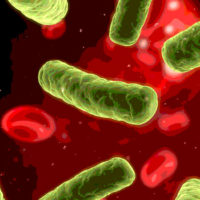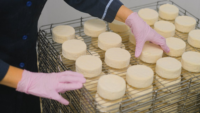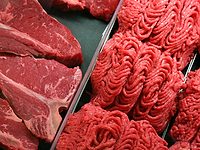Over 20 years ago in a pathogenic microbiology class, I first heard a professor describe pathogenic Escherichia coli and the manner in which the organism and associated serotypes and serogroups were named. He was filled with enthusiasm as he told us that for E. coli O157:H7, the “H,” used to designate the flagellar antigen, was derived from the German word “Hauch” meaning “breath” or “breeze,” and the “O,” used to designate the somatic antigen (found on the surface of the lipopolysaccharide layer of Gram-negative bacteria), was from “ohne Hauch,” or “without movement.” He went on to describe motility testing and how motile bacteria produce a film or cloudiness as they grow and move (swim) through motility media in a tube or spread across plated media. He informed us that while we may never hear of these organisms again, or use these terms in our career, we may find this information useful at some point later in life such as a point of discussion at a cocktail party. Little did he realize the significance and role this information would play in the lives and careers of food microbiologists around the world.
Escherichia coli
E. coli are a large and diverse group of bacteria. While most are harmless and found naturally in the gut microflora of animals and humans, and actually form an important part of a healthy human intestinal tract, some E. coli are pathogenic, meaning they can cause illness.
Enteropathogenic groups of E. coli are categorized into six major pathotypes based on the presence of certain virulence factors and clinical symptoms of infected individuals: Shiga-toxin producing E. coli – STEC; enterotoxigenic E. coli – ETEC; enteropathogenic E. coli – EPEC; enteroaggregative E. coli – EAEC; enteroinvasive E. coli – EIEC; and diffusely adherent E. coli – DAEC. Of these six, STEC is the one most commonly associated with foodborne illness and with regulatory activities including sampling, testing and food-related recalls. Although several serotypes of STEC have been linked to foodborne illness, not all STEC are capable of causing disease in humans. Pathogenic strains of E. coli that produce Shiga toxin (stx) may also be referred to as enterohemorrhagic E. coli (EHEC), verotoxigenic E. coli (VTEC) or STEC.
STEC and E. coli O157:H7
The most commonly identified STEC, at least in North America, is E. coli O157:H7 due to its association with several large outbreaks of foodborne illness and the severity of the illness. STEC has been recognized as a human pathogen since 1982, following outbreaks of an unusual gastrointestinal illness that affected at least 47 people in Oregon and Michigan in February through March, and May through June 1982. The illness was characterized by severe abdominal pain and cramping, initially watery diarrhea followed by grossly bloody diarrhea and little or no fever. The outbreaks were associated with eating at restaurants belonging to the same fast food restaurant chain and with eating sandwiches containing three common ingredients (beef patty, rehydrated onions and pickles). A rare serotype of E. coli (O157:H7), which was not identified as invasive or toxigenic, was isolated from 9 of 12 stool samples collected, and from a beef patty from a suspected lot of meat. The investigators concluded that the organism was likely transmitted by undercooked meat. The only known previous isolation of this serotype was from a sporadic case of hemorrhagic colitis in 1975.
A small percentage of cattle may carry EHEC O157:H7 in their intestinal tracts and on their hides. VTEC O157 have also been recovered from lymphatic tissue and from mesenteric lymph nodes of cattle. Although most cattle are asymptomatic carriers of the organism, E. coli O157:H7 can prove fatal to newborn calves. E. coli O157:H7 has also been isolated from sheep, goats, deer, cats, dogs, poultry, birds and insects. Human illnesses associated with E. coli O157:H7 can be particularly severe, even life threatening, particularly for immunocompromised individuals such as children and the elderly. Symptoms of human infection associated with the organism include bloody diarrhea (hemorrhagic colitis), hemolytic uremic syndrome (HUS), thrombotic thrombocytopenic purpura and death. The virulence of the organism is mediated through Shiga or Shiga-like toxins, which are also known as verotoxins or verocytotoxins. Historically, outbreaks of foodborne illness have linked most cases of infection with E. coli O157:H7 to the consumption of undercooked ground beef. However, outbreaks of infection associated with this organism have also been linked to drinking water, raw milk, apple cider, dry salami, water and produce, including lettuce, spinach, sprouts and cantaloupe. Additional outbreaks have been linked to petting zoos, and person-to-person transmission of the infection has occurred in nursing homes and day care centers. Outbreaks of illness associated with non-beef items have often been linked to cross-contamination during the preparation of raw meat or cross-contamination from animal sources in the environment.
Non-O157 STEC
Over 400 serotypes of non-O157 have been involved in human disease. While STEC have several virulence factors, two major stx types (stx1 and stx2) have been associated with strains causing human disease. Several other virulence factors have also been associated with highly pathogenic strains of STEC, such as the ability to adhere to intestinal cells and the ability to produce a hemolysin; however, not all STEC that cause severe disease possess these factors. This toxin causes blood vessel damage and plays a key role in other events that result in hemorrhagic colitis (bloody diarrhea) and a type of kidney failure called HUS, first described in children in the 1950s, that is characterized by the triad of acute renal failure, hemolytic anemia and thrombocytopenia. STEC, including E. coli O157:H7, is the number one cause of acute kidney failure in children. Worldwide, it is estimated that 20–50% of STEC-related infections can be attributed to non-O157 strains. The estimates are lower in North America, with fewer than 10 percent of HUS cases caused by non-O157 STEC strains. Active surveillance of non-O157 infections in the U.S. began in 2001; since then, the number of non-O157 infections reported between 2000 and 2007 has increased from 171 to 501 cases. The increase in testing is likely the reason for the increased incidence in cases and outbreaks attributed to non-O157 STEC. A wide variety of foods have been implicated in outbreaks as suspected sources, including raw (unpasteurized) milk and cheese, undercooked beef, a variety of fresh produce (e.g., sprouts, spinach, lettuce), unpasteurized apple cider, etc. Two outbreaks have been linked to beef in the U.S. New sources continue to be identified, as evidenced by outbreaks of E. coli O157:H7 infections in Canada and the U.S. linked to walnuts and hazelnuts.
In the U.S., between 1983 and 2002, the six most commonly occurring serotypes of non-O157 were O26, O111, O103, O121, O45 and O145. These six serotypes are reported to make up 82 percent of the FoodNet human isolates of non-O157 STEC between 2000 and 2007. Although numerous non-O157 STEC have been associated with foodborne illness outbreaks, they are historically and less commonly acknowledged due to limitations in diagnostic testing and a lack of surveillance. Due to the lack of well-established phenotypic characteristics of many non-O157 STEC, it has been a challenge to detect these bacteria using more traditional methods; therefore, underreporting of non-O157 STEC is very likely and their importance in clinical disease is not yet sufficiently understood. As with E. coli O157:H7, important reservoirs of non-O157 STEC include the gastrointestinal tract of ruminants, especially cattle, and will not likely cause any illness to their hosts. STEC have also been recovered from animals such as deer, goats, elk, pigs, sheep, horses, dogs, birds and flies. Humans may also serve as a reservoir for the organism. Human infections with STEC can occur with ingestion of contaminated food or water or by direct contact with animals or their farm environment (or petting zoos). Transmission may also occur through direct person-to-person contact with infected people (i.e., secondary infections). Disease symptoms include hemorrhagic colitis and HUS. Foods of animal origin or food and water contaminated with animal feces have been associated with STEC infections. Many nonpathogenic strains of STEC are commonly found in animals, the environment and food. Although the prevalence of pathogenic non-O157 STEC in human and animal populations, in food and in the environment has yet to be established, they continue to be an area of increasing attention in both public health and regulatory arenas. During 2012, due to the potential cause of severe human illness by these organisms, the U.S. Department of Agriculture Food Safety and Inspection Service (USDA FSIS) extended its current definition of “adulterant” and zero-tolerance policy for E. coli O157:H7 to include the top six non-O157 STEC serogroups in raw ground and nonintact beef products. Additional testing is planned for other raw beef components, such as manufacturing trim, intended to be used for raw ground beef or non-intact beef products.
Detection Methodologies
The clinical diagnosis and tracking of possible sources of non-O157 STEC infections has historically been hindered by the lack of sensitive and specific tests capable of isolating, identifying and quantifying pathogenic non-O157 STEC. As previously mentioned, a lack of well-established phenotypic characteristics of many non-O157 STEC has made it a challenge to detect these bacteria using more traditional culture methods, particularly in distinguishing pathogenic from nonpathogenic strains. The development of sensitive and specific test methods is also confounded by the considerable scientific uncertainty surrounding the exact combination(s) of virulence factors required to confer pathogenicity to certain strains of STEC. The diversity in range and types of virulence factors associated with STEC infections in humans and food makes it difficult to define a single virulence trait, making it likely that virulence may result from a combination of factors. Since 1982, when E. coli O157:H7 was first reported, selective diagnostic methods, such as chromogenic agars, have used particular features of E. coli O157 to increase the isolation of this particular strain. Because of the use of these selective methods, the prevalence of non-O157 STEC has likely been underestimated. Both O157 and non-O157 STEC have also been detected using multiple test methods, and in some cases, a combination of several screening and confirmation tests, such as immunomagnetic separation, flow cytometry, plating and molecular methods that do not exert selection pressure toward any particular serotype, such as detecting stx and/or eae in samples by PCR screening assays followed by a PCR assay targeting O-antigen genes. Since the implementation of the USDA FSIS regulation on six non-O157 STEC serogroups in raw beef products, the demand for rapid, sensitive and cost-effective tests for non-O157 STEC in food has expanded considerably. The already-competitive market for test kit manufacturing has companies intensifying their efforts to develop and validate such kits. As new strains continue to emerge and be identified, test kit manufacturers and researchers should remain vigilant and continue to develop more rapid and sensitive diagnostic tests based on a consensus about the specific targets, that is, virulence genes, that need to be identified and the required detection limit threshold.
Control Measures
Due to the low infectious dose and severity of disease manifestation for most STEC, their presence in raw and processed foods poses an important health risk. Several factors affect the growth and survival of STEC in foods. These include temperature, pH, salt content, atmosphere and water activity. For example, E. coli O157:H7 can grow in the presence or absence of oxygen, with an optimum temperature for growth of 37 °C (minimum 7–8 °C) and over a pH range of 4.4 to 9.0, and can survive in some products at a pH as low as 3.6.
In developing and implementing control measures, different approaches are necessary based on identified hazards and associated risks. For example, foods such as fresh produce can become contaminated with STEC from the presence of wild and domestic animals in fields and orchards, from the use of contaminated water sources, runoff from animal production units or lagoons, birds or dust and insects from animal production facilities. Although the benefits of manure-based soil amendments are well documented, inadequately treated compost can contribute to fresh produce contamination on the farm. With epidemiological results showing an increase in non-O157 STEC cases in produce surpassing those of E. coli O157, it is critical to evaluate the behavior of non-O157 STEC strains in animal manure-based compost. Research results to date show that STEC may survive in animal compost for extended periods, although some data suggest that survival of STEC may be strain and soil specific. Therefore, proper handling, testing and validation of composting Standard Operating Procedures for animal manure, to be used as a soil amendment, are critical for ensuring the microbiological safety of fresh produce and the farm environment.
Proper cooking of animal foods, such as ground beef and nonintact meat products, and commercial pasteurization of milk have been shown to be effective in eliminating STEC such as E. coli O157:H7 from foods. Available heat-resistance data substantiate that non-O157 STEC of concern have heat resistance similar to or less than that of O157.
Several studies have reported that antimicrobial intervention strategies currently used (and designed) to reduce E. coli O157:H7 on beef surfaces are also likely to be as effective against non-O157 STEC when applied to pre-rigor meat surfaces. However, some studies have shown that specific serogroups may be more or less sensitive to these treatments when applied to chilled meat surfaces. The effectiveness of antimicrobials to reduce pathogenic bacteria on meat surfaces will vary depending on several factors, such as the target microorganism, inoculum level (low versus high), type of antimicrobial used, concentration of antimicrobial, combination of interventions (such as hot water and/or organic acid), number of applications (such as pre- and postchill applications), surface type and so on.
When all is said and done, there is a lot we still do not know about Shiga toxin-producing E. coli and about non-O157 STEC in particular. However, armed with the desire to reduce the incidence of foodborne illness outbreaks and to protect public health, combined with improvements in testing methodology and an ongoing regulatory focus, our body of knowledge about this group of organisms continues to grow, as does the safety of the foods we produce.
Margaret D. Hardin, Ph.D., is vice president of technical services at IEH Laboratories & Consulting Group. Previously, Margaret held positions at Texas A&M University, Boar’s Head, Smithfield Packing Co. and Sara Lee Foods. She currently works closely with the food industry in food safety and food microbiology-related areas. She is a member of the Editorial Advisory Board of Food Safety Magazine.




